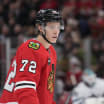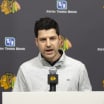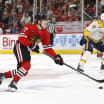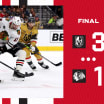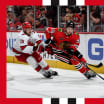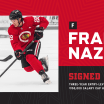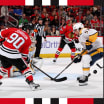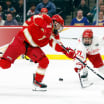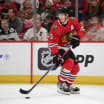With rare exception, they are names to be played later. When the National Hockey League Draft unfolds in Vancouver in late June, rest assured that the Blackhawks, by selecting third, shall choose an outstanding young prospect. Also, feel free to assume that he will require an introduction.
THE VERDICT: Three is good company
Team Historian Bob Verdi takes a look back at some of Chicago's history at third overall, including their drafting of Eddie Olczyk and Denis Savard
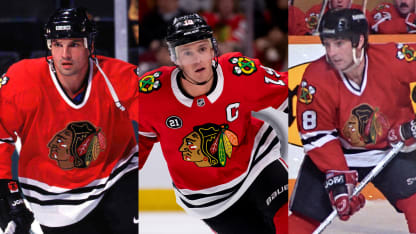
By
Bob Verdi
Blackhawks.com
However, securing a No. 3 slot despite only an 8.2 percent chance of doing so removes some of the sting, which might explain why there is only a 2.8 percent chance that Senior Vice President/General Manager Stan Bowman will stop smiling for the next two months.
Besides Toews, the Blackhawks can thank a No. 3 overall post position for Denis Savard and Eddie Olczyk. Dylan Strome, another No. 3, joined the team in midseason. Karma for that pecking order extends to their United Center co-tenants. Michael Jordan was a transformational catch at No. 3 for the Bulls in 1984. You can look it up, or just snap a selfie next to his statue.
Come June, Jack Hughes is the presumptive No. 1, there for the taking by the New Jersey Devils. Kaapo Kakko is likely to go No. 2 to the New York Rangers. With the No. 3, Bowman has options to exchange it for active talent, trade down, or hold firm for the best available athlete: maybe Canadians Bowen Byram, a defenseman, or Dylan Cozens, a center; or Vasili Podkolzin, a 17-year-old right wing presently lighting it up in Russia. All are unfamiliar to most of us, but not for long.
Olczyk was an outlier in 1984 because he grew up here, played on the United States Olympic team, and loved the Blackhawks. How much they loved him was the question.
"I thought it was a longshot, but if you know me, you know how I like longshots," recalled Eddie O, the Blackhawks' popular TV analyst and a student of thoroughbred racing. "The Pittsburgh Penguins were going to take Mario Lemieux at No. 1. I thought I might go to the Devils at No. 2, but they took Kirk Muller. Los Angeles was next, and the word was that they would pick a defenseman. So I figured I might wind up at No. 4 with the Toronto Maple Leafs. Then there was a timeout on the floor."
The Blackhawks, at No. 6, consummated a trade with the Kings for their No. 3. Goalie Bob Janecyk went to Los Angeles, which wound up with its desired defenseman, Craig Redmond, plus Chicago's third- and fourth-round picks. The latter was used on Tom Glavine, who would become a brilliant pitcher for the Atlanta Braves. When they were called, the Blackhawks took Olczyk, the first American ever drafted by his hometown team in the first round.
"Pretty cool moment," recalled Eddie O. "I lived and died with the Blackhawks as a kid, sitting in the Stadium, looking through the glass and dreaming. I had met with Bob Pulford, their general manager, and Jack Davison, their head scout. They expressed interest, but you never know. I later heard they also made a deal, the one that sent Rich Preston to New Jersey, so the Devils wouldn't take me. Whatever, I was thrilled.
"I signed for what they offered, $75,000. That's pretty good, when you're 18, making $80 a week as a caddy in your spare time. There was a lot of fanfare, me being an American and from Chicago. I didn't ask for it, and there might have been some people who felt it was over the top. But the guys on the team were great. Steve Larmer, Denis Savard, Doug Wilson, Tommy Lysiak, Keith Brown, Troy Murray. I could name ten more. And the timing was good. We were right on the verge."
Olczyk is such a famous broadcaster, one can misplace his accomplishments on ice: 342 goals in 16 NHL seasons, and induction into the United States Hockey Hall of Fame.
Savard didn't travel far for the 1980 draft. As usual then, it was at the Montreal Forum. Though a splashy junior there, Savard did not detect vibes that the mighty Canadiens coveted him.
"When you play so many games there like I did, their scouts were watching all the time," recalled Savard. "And that means they also see your flaws. No way was I a polished hockey player. Besides, the rumor was that the Canadiens wanted a big center to play with Guy Lafleur."
Indeed, Montreal chose Doug Wickenheiser and the Winnipeg Jets tabbed Dave Babych. The Blackhawks, at No. 3, grabbed Savard, deemed too small by some experts.
"My father, Arthur, made me do a very smart thing," Savard went on. "He made me go to Chicago two weeks before training camp, maybe three. He said the Blackhawks would be skating on their own, and I should join them. The day I flew out of Montreal, he and my mother, Jacqueline, took me right to the gate. You could do that then. I was crying, big time. But I told them, 'I'm not coming back here to play more with the Montreal junior team. I'm going to make the Blackhawks.'''
In a strange city, Savard holed up in the Bismarck Hotel, owned by the Wirtz family.
"I skated every morning, then came back to my room to watch the Cubs on channel 9," he said. "I only knew enough English to order breakfast across the street. 'Two eggs, bacon, potato, toast, orange juice.' Dinner was steak and fries and a Coke in the room. When exhibition games started, my coach, Keith Magnuson, played me a lot. Power play, penalty kill, everything. Stan Mikita had just retired. Maggie showed a lot of confidence in me. He was great.
"So were the guys. Keith Brown, who is a saint, had a house in Elmhurst. He asked me to move in with him. That was before he was married. All the guys were great, but Brownie really took me under his wing. Another young Frenchman, Florent Robidoux, moved in too. Then Miles Zaharko. I washed the dishes. No cooking, just eating."
Savard quickly proved he was NHL ready. In his second regular season game at the Forum, he put a major move around Larry Robinson, a stellar defenseman, and ripped his first NHL goal past Denis Herron. Savard added two assists toward a 5-4 victory against the Canadiens and was named first star. He scored 28 goals as a rookie and fans started flocking back to the Stadium to observe a future Hall of Famer. He also received high praise from upstairs.
"Denis Savard," said President Bill Wirtz, "saved our franchise."

